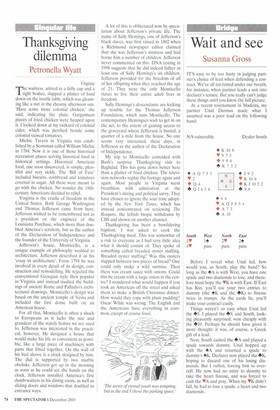Thanksgiving dilemma
PetTonella Wyatt
Virginia
The waitress, attired in a frilly cap and a tight bodice, slapped a platter of food down on the trestle table, which was gleaming like a nut in the rheumy afternoon sun. 'Have some more colonial chicken,' she said, indicating the plate. Gargantuan pieces of fried chicken were heaped upon it. I looked down at my tankard of colonial cider, which was perched beside some colonial stewed tomatoes.
Michie Tavern in Virginia was established by a Scotsman called William Michie in 1784. Now it is one of those historical recreation places serving historical food in historical settings. Historical American food, one soon discovered, is simple, plentiful and very sickly. The 'Bill of Fare' included biscuits, cornbread and tomatoes covered in sugar. All these were meant to go with the chicken. No wonder the 18thcentury Americans decided to rebel.
Virginia is the cradle of freedom in the United States. Both George Washington and Thomas Jefferson came from here. Jefferson wished to be remembered not as a president or the engineer of the Louisiana Purchase, which more than doubled America's territory, but as the author of the Declaration of Independence and the founder of the University of Virginia.
Jefferson's house, Monticello, is a unique example of philosophy wedded to architecture. Jefferson described it as his 'essay in architecture'. From 1794 he was involved in every detail of its design, construction and remodelling. He rejected the conventional Georgian style then popular in Virginia and instead studied the buildings of ancient Rome and Palladio's architectural drawings. Monticello's design was based on the ancient temple of Vesta and included the first dome built on an American house.
For all that, Monticello is often a shock to Europeans as it lacks the size and grandeur of the stately homes we are used to. Jefferson was interested in the practical, however, He designed a house that would make his life as convenient as possible, like a large piece of machinery with parts that fitted together. On the wall of his bed alcove is a clock designed by him. The dial is supported by two marble obelisks. Jefferson got up in the morning as soon as he could see the hands on the clock. Jefferson installed America's first dumb-waiters in his dining room, as well as sliding doors and windows that doubled as entrance ways.
A lot of this is obliterated now by speculation about Jefferson's private life. The name of Sally Hemings, one of Jefferson's black slaves, was first raised in 1802 when a Richmond newspaper editor claimed that she was Jefferson's mistress and had borne him a number of children. Jefferson never commented on this. DNA testing in 1998 suggests that he did indeed father at least one of Sally Hemings's six children. Jefferson provided for the freedom of all of her offspring when they reached the age of 21. They were the only Monticello slaves to live their entire adult lives in freedom.
Sally Hemings's descendants are kicking up trouble for the Thomas Jefferson Foundation, which runs Monticello. The contemporary Hem ingses wish to get in on the act, to the extent of gaining access to the graveyard where Jefferson is buried, a quarter of a mile from the house. No one seems very interested, these days, in Jefferson as the author of the Declaration of Independence.
My trip to Monticello coincided with Bush's surprise Thanksgiving visit to Baghdad. This has gone down better here than a platter of fried chicken. The television networks replay the footage again and again. Most people in Virginia seem breathless with admiration at the President's daring and political savvy. They have chosen to ignore the sour tone adopted by the New York Times, which has instead concentrated on reviewing The Reagans, the leftish biopic withdrawn by CBS and shown on another channel.
Thanksgiving has been a bewildering baptism. I was asked to cook the Thanksgiving meal. This was somewhat of a risk to everyone as I had very little idea what it should consist of. They spoke of something called breaded oyster stuffing. Breaded oyster stuffing? Was this oysters slapped between two pieces of bread? One could only make a wild surmise. Then there was cream sauce with onions. Could this be cream with a large onion in the centre? I wondered what would happen if you took an American off the street and asked them to make a British Christmas dinner. How would they cope with plum pudding? Oscar Wilde was wrong. The English and the Americans have everything in common, except of course food.


























































































 Previous page
Previous page